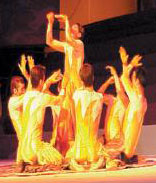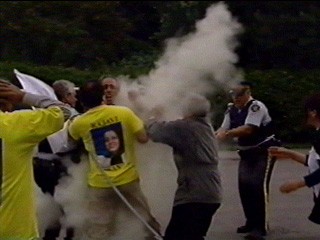An interview with Batool Soltani on MKO self-immolations – Part fifteen
Sahar Family Foundation: Ms. Soltani, you averred that the reaction of the members of the Leadership Council to Maryam’s arrest was a histrionic rather than genuine; a mixture of pretense, sincerity, and the agitated atmosphere that made quite an impression on the audience. Then, it becomes clear that in spite of the created flutter following the news of Maryam’s arrest, the shown sentiments lacked the needed depth and most were imitating and role playing feelings. In such an abrupt outpour of emotions, it won’t be surprising to see a senior member, excited and impressed by the atmosphere, set himself on fire. Imagine what would have been the effect on the lower ranks.
Leadership Council to Maryam’s arrest was a histrionic rather than genuine; a mixture of pretense, sincerity, and the agitated atmosphere that made quite an impression on the audience. Then, it becomes clear that in spite of the created flutter following the news of Maryam’s arrest, the shown sentiments lacked the needed depth and most were imitating and role playing feelings. In such an abrupt outpour of emotions, it won’t be surprising to see a senior member, excited and impressed by the atmosphere, set himself on fire. Imagine what would have been the effect on the lower ranks.
Now my question is, what process had it to follow to convince and instigate others to practically engage in self-immolations, peoples like Neda, Marzieh and many others. Of course, even Rajavi himself knew well that there was no rationale for such practices and maybe laughed at the simplicity of the suicide. The question is what were the factors that forced these emotionally grounded outbursts into action and what role did the organization play as the motivator? And how these ostensibly arbitrary actions could be tallied with their concretely orchestrated nature as a show of strong commitment?
Batool Soltani: It is a little hard to analyze the case. I mean, we cannot precisely decide about the motives and their classification. In one point, it is a matter of strong commitment among the high ranking members, that is, their step by step education to reach a point where you may call it transmutation, I call it commitment, but in organizational teachings they call it ‘unification point’ or identification of within and without. We have already talked about the sophisticated psychological techniques cults manipulate for coercive persuasion or thought reform of the insiders. There are so many cults that have professionalized their approaches and techniques of persuasion as you can well trace in Al-Qaeda. But I think it is much more complicated when we talk about the organization since it utilizes a combination of techniques just in the same way that its ideology is eclectic.
However, the organizational preparedness of volunteers cannot be disregarded. They are people who can be said to have reached a point of selflessness. They have been trained to do whatever they have been imbued with. Some of them may have reached top echelons through a cunning role playing but the majority has succeeded to convince seniors about their truthfulness of actions and intentions. Some are really nasty with repulsive behavior; they may even pass over their most beloved to prove their loyalty and commitment. These are the main actors of the case we are talking about and, consequently, the lower ranks are mostly impressed by the ideas they impregnate them with. Let’s return to concrete aspects of your question.
I assure you that if what happened in France was to happen inside Camp Ashraf. Mozhgan (Parsai) would be the first to take a gallon of gasoline to run towards Americans. Have no doubts that even me, who was skeptical of the whole issue, would follow her with another gal. Logically enough, other chief rankings would catch her to avert her act of immolation. But the story would not end here because her move had already agitated some in hot pursuit whom nobody came to stop and you could soon see human torches running around. It is a general formula within the organization and it makes no difference where the scenario is to be put into practice, in Ashraf, Auvers, or any other part of the world.
I have no doubt that in Paris’s immolations seven or eight seniors like Mozhgan had rushed to set themselves on fire. These are professional starters whose main role, as I explained, is to provoke others to follow. The members who set themselves on fire, like Marzieh Babakhani, Sediqeh Mojaveri and Muhammad Sani, were ranking members who had followed the professional starters who in turn had been stopped mid-way while the others went on to finish the job. None of these people, including those I named, immolated on arbitrary decisions and I am sure they had been fully briefed on the operations they had been chosen to carry out in the headquarters of Paris and London; they dad been fully crosschecked in a process of mood-altering program and relevant ideological commitment to leadership to avert any antagonistic attitude that might cause them to shrink from fulfilling the mission. To tell the truth, I closely knew Marzieh Babakhani; she was, I beg your pardon for using such terms, a real charlatan and quarrelsome who indeed played a key role to provoke others and charge the atmosphere with sentiments that could easily be a trigger for action.
Indeed, she played the very same role as Mozhgan, or Beheshteh Shadroo and other similar rankings under Rajavi’s direct command could have in the Camp Ashraf. I have no doubt that one or two of these seniors rushed into the street towards the Police with gallons of gasoline in hand; naturally sub-rankings like Neda (Hassani) and others dashed after them. On the way, the forerunner ranking, suppose she was Beheshteh Shadroo, received a message ordering her to return since she had no right to set herself on fire. It is a general process within the organization with numerous examples to spotlight. The scenario might be planned to be played either for immolations or other disciplinary cases.
For instance, one had to be rebuked and scolded before other members in a general meeting. While he was speaking, one like Abbas Davary, who had already been assigned for the purpose, started to assail him and yell at him. A few other members automatically stood to join Davary as assailants. Here, Davari’s mission was over and he would sit down to let others continue.
Most of the time, those who got involved in the assail had no real reason for what they were doing; the only thing they knew was that they had to enthusiastically continue along with the others in the raised fuss. In such an agitated climate, all tried to conform and hardly anyone opted to remain passive. It is the same scenario put into practice in the pattern of self-immolations; one senior starts and sub-rankings hurry after to take their opportunity of displaying commitment. They are the real victims who may be unaware of the good reason for what they are doing.
The organization sees no reason to brief victims on what they have to be sacrificed for. Only the seniors and those who are the leading starters receive the appropriate trainings and instructions concerning safeguarding the interests of the organization and leadership. They are trained how to start and provoke others to continue with the mentality of injustice imposed on the organization and a due responsibility to stand up for restoration of justice. The members never receive similar trainings in the organization. Marzieh Babakhani and I were both in offices in London and members of the Leadership Council but with different ranking status; there was a body called the Leadership Council but with a variety of hierarchical levels and what promoted members was the degree of their devotion and commitment to the leadership.
Sediqeh Husseini and I were simultaneously announced as the members of the Leadership Council but soon she was promoted to first secretary while I had made no advance to upper organizational ranking as I failed to follow her in growing the sense of commitment. They know on whom they invest for the critical situation as she did set herself on fire when the time came.
This is through such approaches that the organization prepares to counteract impending crisis. The death of Neda Hassani as a result of her self-immolation was the outcome of an abrupt emotional burst to rush after a catalyst who was never intended to commit the suicide. Look at Neda’s age, education and depth of her political background. She fails to be qualified and experienced enough to be included in the circle of senior rankings; she belongs to the class of the victims who was stirred into action just in the middle of an agitated climate to display her so-called commitment to the leadership.
It is in total contrast with what the organization usually advertizes for the public outside to boast about the rank and file and sub-rankings as the main body whose decision runs the main policy of the organization and affects the leadership’s decision makings. As Rajavi rudely put the responsibility of his egocentrically initiated armed phase on the members and claimed that it was the members who convinced the leader to adopt an inevitable decision.
Or when they referred to Ahmad Rezai’s suicide operation whenever talking for the rank and file, they intended to instill into them he was a leading ranking who had committed suicide to become an archetype for lower ranks to follow. The adopted approach has undergone a qualitative change through the years but the mindset of sacrificing for the survival of the organization and safeguarding the interests of the leadership have been increasingly fortified.
To be continued



